The Chow Chow is a very unique dog breed with its own unique feeding habits, but what does a Chow Chow puppy feeding chart look like?
Well, while unique, a Chow Chow puppy feeding chart isn’t all too different from any other. In fact, it somewhat resembles that of the Chinese Shar-Pei given its similarities.
However, it’s still important to know the average ranges which you should abide by when feeding your doggo to keep his weight in line as a dog being either under or overweight is each a hazard on its own.
While a feeding chart won’t give you the precise measurements you’ll need for your precious pooch, it does serve as a good guideline, a foundation on which to base your dog’s specific diet on.
It’s a good starting point that you then get to fine tune depending on your furry friend’s specific preferences and needs.
Of course, aside from the calories, one needs to ensure that the food being fed to him contains the necessary nutrients and vitamins he needs to thrive and grow, especially during his puppy years.
High-quality dry dog food is always recommended.
And, of course, the amount of calories needed and other nutrients and vitamins depends on a few factors like genetics, metabolism, gender and the like.
So, if you’re looking to find out what this feeding chart looks like, what affects it and other interesting things regarding the topic at hand, as well as answers to some of the most common questions about it, be sure to read on.
The Chow Chow Puppy Feeding Chart
| Age | Male Weight | Female Weight | Cups Per Day |
|---|---|---|---|
| 3 Months | 21 – 26 lbs | 18 -23 lbs | 2/3-2 cups |
| 4 Months | 28 – 40 lbs | 23 – 30 lbs | 1 3/4 – 3 1/3 cups |
| 5 Months | 39 – 42.5 lbs | 27 – 37 lbs | 1 3/4 – 3 1/3 cups |
| 6 Months | 40 – 49 lbs | 32.5 – 42.5 lbs | 1 2/3 – 3 1/4 cups |
| 7 Months | 44 – 54 lbs | 36 – 47.5 lbs | 1 2/3 – 3 1/4 cups |
| 8 Months | 47 – 59 lbs | 38 – 51 lbs | 1 2/3 – 3 1/4 cups |
| 9 Months | 49.5 – 62.5 lbs | 40 – 54 lbs | 2 3/4 – 4 cups |
| 10 Months | 51.5 – 63 lbs | 41 – 56 lbs | 2 3/4 – 4 cups |
| 11 Months | 52.5 – 66 lbs | 42.5 – 55.5 lbs | 2 3/4 – 4 cups |
| 12 Months | 53.5 – 68 lbs | 43 – 58 lbs | 5 1/4 cups |
| 13 Months | 54 – 69 lbs | 44 – 58 lbs | 5 1/4 cups |
| 14 Months | 55 – 70 lbs | 44 – 59 lbs | 5 1/4 cups |
| 15 Months | 55 – 70.5 lbs | 44 – 59.5 lbs | 5 1/4 cups |
As you can see, Chow Chows start off quite chunky and procedurally gain a lot of weight in the initial months.
That gain then starts to gradually decrease in the latter half of their first year of life and they reach their final, adult weight by the end of puppyhood.
But, even with that, the amount of food increases. That’s because their body grows in proportion, and not just their weight, a body that needs more calories to support its new weight.
After all, even with a medium activity lifestyle, the Chow Chow is still going to be burning more calories the bigger he is by just moving around.
The one thing the chart doesn’t show is the actual adulthood. That’s because the feeding amount usually caps out at this stage and will start going down as your dog ages further.
That period is usually different for every dog and requires a lot of fine tuning on your end.
Keep in mind, so do these first 14-18 months of age, but the later is even more so.
You’ll likely have to start gradually dropping the amount of cups of food per day that you feed him at around year 4-5, something around that mark and continue on until he reaches his senior years.
Once that comes up, you’ll be swapping over to food that’s easier to chew and digest to make it easier for him to eat without risking any potential health issues from rearing their ugly heads.
Chow Chow Food Habits Over The Years
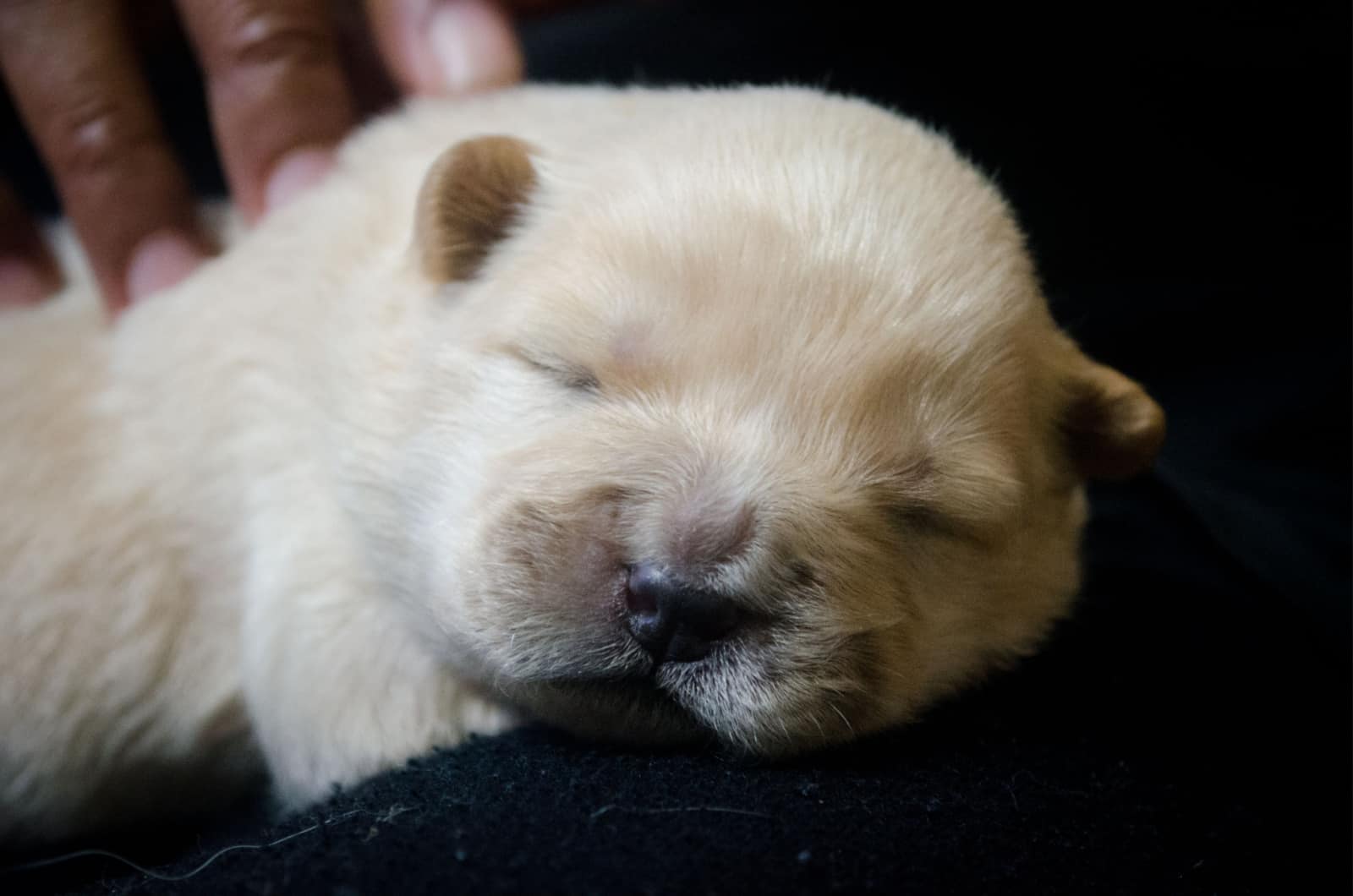
Feeding a Chow Chow puppy a healthy and balanced diet over the course of his life is key to maximizing his lifespan while minimizing the chances of any of the more common health issues from popping up.
However, a dog’s diet changes over the years and there are a few tricks that every dog owner should be aware of to make life a whole lot easier for them, especially when it comes to swapping food brands out.
Here’s what a dog’s life looks like throughout the years:
0-2 Weeks Of Age
From birth, to about half a month of age, pups aren’t taken care of by you as much as they are by their mother. She’s the one responsible for feeding them during this period where they’re extremely vulnerable.
They’ll use this time to imprint on their mom and bond with her for as long as they are around her.
The familiar warmth and heartbeat serve as comfort for them while the milk provides them with all of their nutritional needs.
However, you will have to feed the mom, enough to support herself and her kids which usually means a good amount more than what her standard diet would be.
When they’re this big, they barely weigh a pound or two, but do get that weight up pretty quickly.
3-8 Weeks Of Age
This is the period where the dogs start becoming more physically active, the puppies gain access to most of their motor functions and start exploring the surrounding area.
Their mom still feeds them for weeks 3-4, after that, it’s advised to start weaning them off the mother’s milk and onto puppy kibble so they could get used to their soon to be new life in another home.
It’ll also help them gain body weight at a steadier pace since you can now control their feeding rather than have them almost free feed of their mother’s milk.
The weaning here is done with a process that most dog breeders use. They take either a milk substitute or some water and mix it in with the desired dry dog food brand. Three parts liquid to one part kibble, and mix it in.
Then, once the dog takes to it, they gradually start to shift the ratios in favor of the kibble until, finally, it’s the only thing that’s in there and he’s happily eating away at it.
A relatively simple and easy process that’s sure to work most of the time. It’s also useful later on in your dog’s life when you want to move him over to another dog food brand, just replace the water with the old kibble in this whole process.
This should all mostly be complete by week 8 at which point they’re ready to be rehomed. That, and some basic behavioral training, but that’s not the theme of this article.
8-12 Weeks Of Age
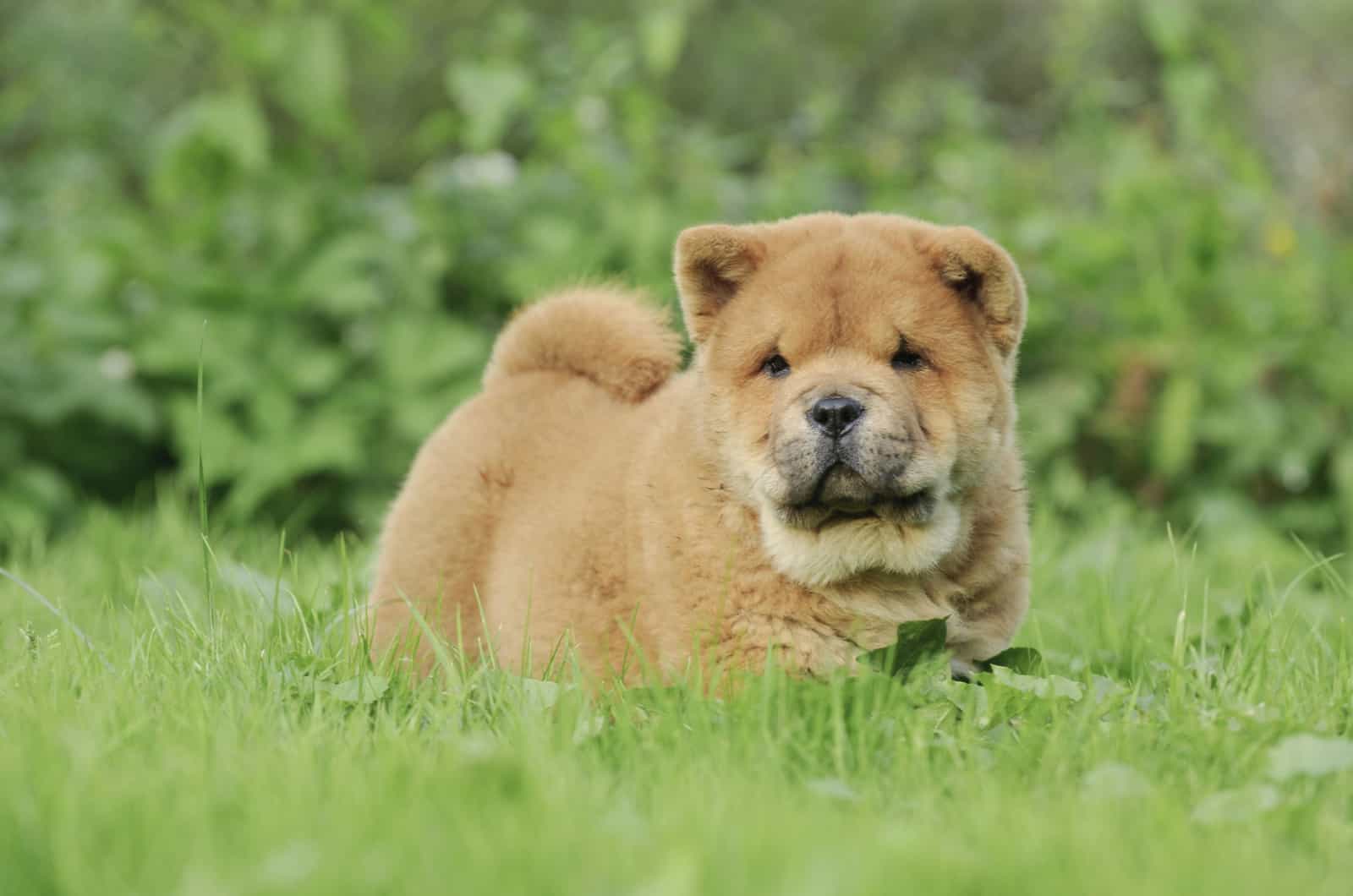
At this point, the dog should be with his new family. If this family is you, then this is the point from which your role in this begins.
Your doggo may be sad that he was separated from his mother at first, but that feeling should fade over a few days up to a week as he gets used to his new home.
Make sure to feed him the same kibble that his breeder used to make that transition easier, otherwise, you may get a dog that refuses to eat on your hands, which is not going to be good by any means.
4-9 Months Of Age
This is the final period where your dog grows in height and arguably the last intense period of feeding left as his food needs start to gradually increase.
Follow the chart accordingly and add calories if needed.
Though, at this point I’d advise also starting to consult with a vet or a pet nutritionist so you can start shifting the diet around to suit it to your canine companion’s needs.
By month 9, he would be considered an adult in terms of height, as that won’t grow much more for the latter half of his puppy years, maybe an inch or two.
The rest of his growth will occur with his weight as he bulks up to be able to hold enough muscle and mass on him to sustain this new height of his.
10-18 Months Of Age

As I’ve said prior, most of this period will be spent gaining weight and getting the Chow Chow to fill himself out nicely until he reaches the end of his puppyhood and transitions into his adult years.
This transition can happen anywhere from month 14 to 18, so do be aware of when it does happen.
The sign is usually him reaching the average weight of an adult dog at which point you should be making the transition from puppy food to adult dog food as the former has more fat and protein in it than the latter which isn’t good for long term health.
Adulthood (Month 14 – Year 7)
During your Chow Chow’s adult years, not much will change apart from the aforementioned fine tuning of his diet based on his tastes and his specific metabolism, food allergies, deficiencies, the occasional illness and the like.
Other than that, he should primarily be on dry adult dog food with a sprinkle of wet food and some human food that is digestible by dogs here and there.
As he slowly reaches his senior years, his metabolism will start to slow down and so should his food portions to compensate for it.
If you notice your dog gaining too much weight, start lowering the portion sizes until he gets back to the acceptable weight range.
It’s not rocket science, but it may take a bit of trial and error to get right.
The Senior Years (Year 7 And Onward)
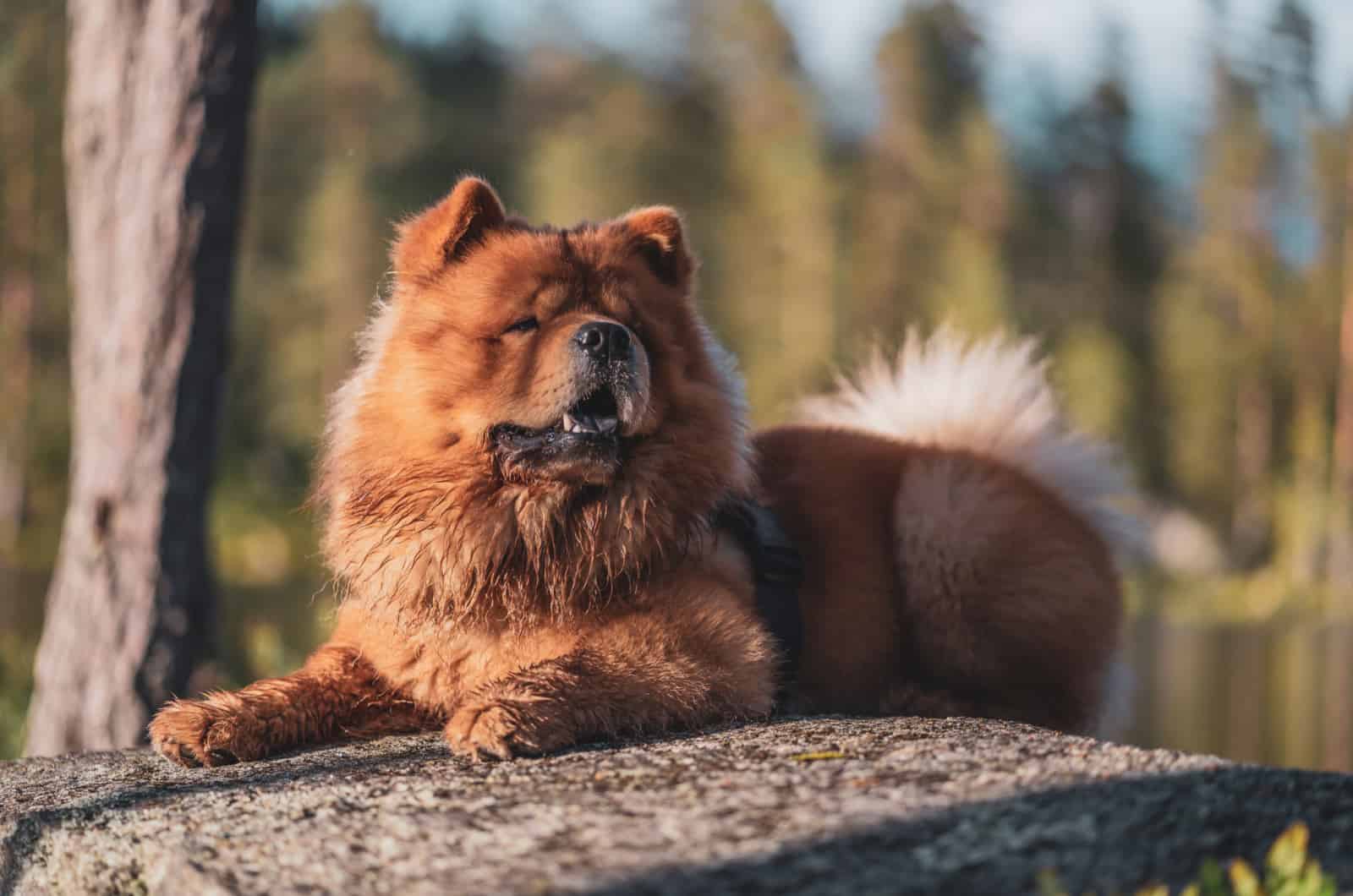
On the final length of your furry friend’s journey are his twilight years, a part of his life that can last anywhere from a year to five, with some of the healthier ones going all the way up to year 15.
During this time, most people switch their dogs over to kibble oriented toward senior dogs, softer and easier to digest with less calories in it.
Some other dogs can go on using the adult dog food too, but it’s honestly just a matter of preference anyway.
Whatever the case may be, be it for swapping from puppy to adult, or from adult to senior dog food, using the trick with the ratios slowly shifting toward the new stuff is going to work in all of these cases.
What Affects A Chow Chow’s Daily Food Intake?

The amount of food one dog can eat on a daily basis is usually different than that of other dogs due to a few key factors that come into play for all of them.
Here are some of the most influential ones:
His Genes
Genes determine everything, from appearance to predisposition to inheriting various diseases from one’s parents and the speed of one’s metabolism and the Chow Chow is definitely not exempt from it.
Genes can determine various allergies in a dog’s body which may or may not alter his diet to something different than normal, lowering the amount of food options he may have available to him, or brands in general.
Other than allergies, his metabolism may end up being naturally slower than that of other dogs, so he may need to eat less to be sated and won’t be as effective in burning calories as some other dogs might be.
If you’re unsure whether or not this could be the case, simply give your pet’s vet a call so he can give him a check-up and diagnose what exactly is wrong with him, as it could be something else entirely.
His Diet
A healthy weight is the key to maintaining a long and happy life for a dog like the Chow chow, especially since he’s prone to various bone issues like elbow and hip dysplasia and being overweight only makes that more likely to occur.
Going on different dietary plans is going to be commonplace for your dog as you try and find the one that fits him the best while still keeping him in shape.
Truth be told, there are many of them out there, from the standard ones, to raw diets where dogs eat raw meat mixed in with some other ingredients like eggs and vegetables.
The latter, while considered healthy for some dogs, in reality should still be done with meat that’s at least been cooked to a degree where it eliminates any potential bacteria or viruses that may cause harm to your canine companion,
That said, Chow Chows in particular aren’t particularly lovers of meat so it’s not really the most recommended dietary plan for them.
Regardless, a proper diet is key as being underweight is just as dangerous as being overweight for various reasons, so try and find the right balance to keep him within the designated weight range.
And, of course, finding the right food is necessary too, for puppies especially.
You’ll want DHA and EPA to be present in their chow as these nutrients help develop and improve cognitive function in young dogs.
You’ll also want calcium and phosphorus which aid in improving bone and joint structure and are particularly helpful in preventing the aforementioned hip and elbow dysplasia.
Key vitamins that you should be on the lookout for are vitamins A and E to improve your dog’s eye health as, next to bone problems, the biggest issue Chow Chows have to deal with relates to their eyes.
A lot of the best food contains prebiotics and probiotics too, to help strengthen a dog’s digestive system by boosting his gut flora.
You’ll want a good source of protein in it too like chicken, beef or turkey, fish to a slightly lesser degree, but it can work too.
Just try and avoid meat by-product as the main ingredient if you can as those mostly serve to inflate calories.
Finally, if you ever feel lost on how much you need to feed your dog, you can always look back at the feeding chart here, or resort to the feeding guide that most brands have printed out on their dry dog food bags now.
This is especially true since not all kibble has the same caloric content so the cup counter shifts based on it. Just look for your dog’s current weight and apply accordingly.
His Daily Exercise Amount
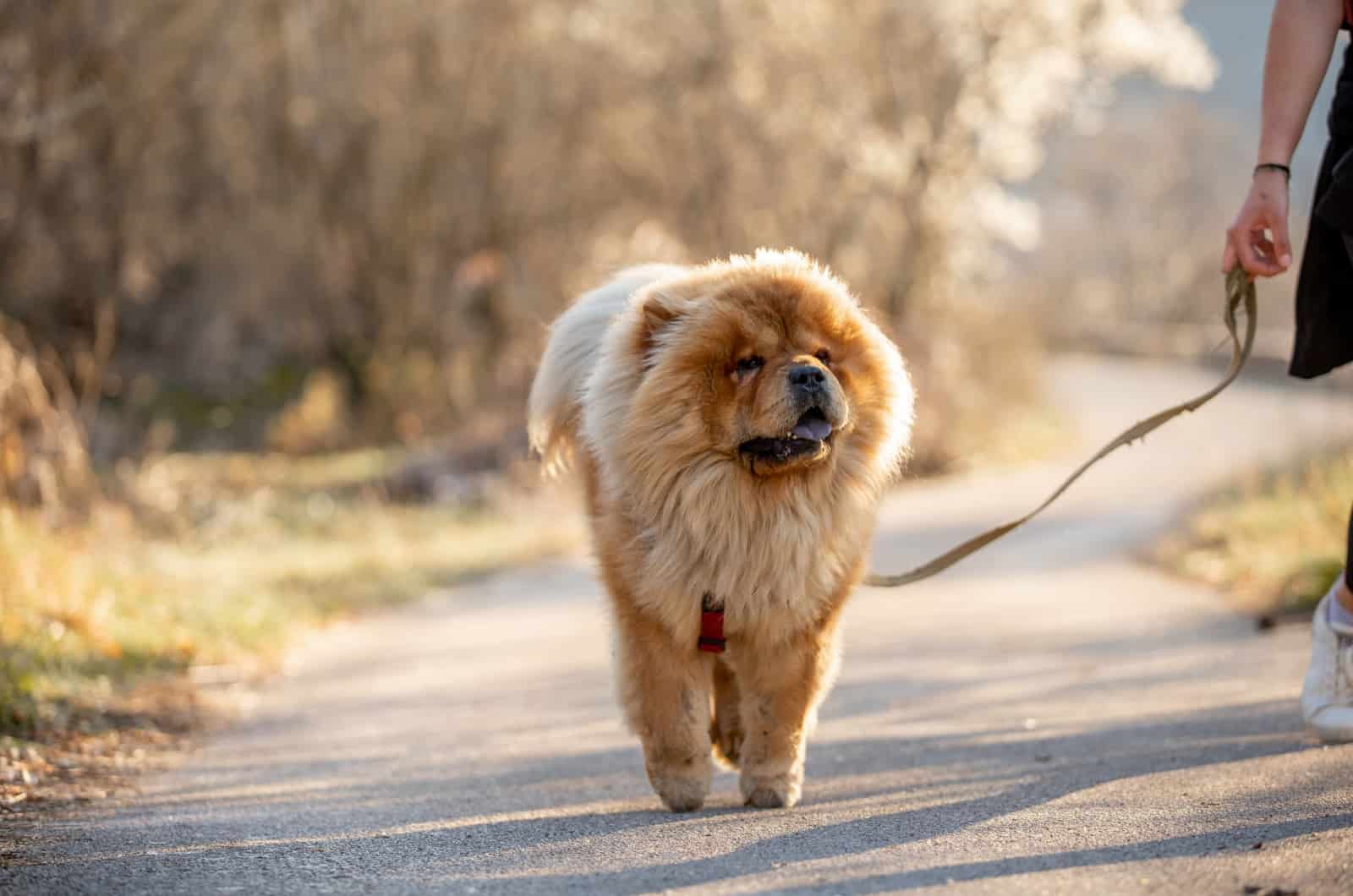
And, of course, apart from the allergies, genetics and dog food, exercise is the final major factor in this whole process.
If your dog lazes around all day, one would assume that he’s going to need a lot less calories for the day due to a lower activity level.
However, if you keep your dog physically active and get him his daily exercise in, his caloric needs will increase depending on the amount of exercise done.
Thankfully, these fuzzy cuddle bugs don’t really need all that much exercise as they’re brachycephalic dog breeds, meaning their breathing isn’t exactly easy due to the facial features that obstruct the airways.
It’s the same as the Bulldog, Pug or Chinese Shar-Pei.
Regardless, this means that they only really need up to an hour of daily exercise which includes walks, and none of it really high intensity.
However, meeting this requirement will definitely improve your Chow Chow’s health for the better and will allow him to potentially live a longer life.
What To Feed A Chow Chow Though?
Well, even though protein is necessary, the Chow Chow doesn’t eat an awful lot of meat in their daily diets because, back in ancient times, they were trained to eat only small amounts of meat.
The rest was usually replaced with vegetables, dairy products and peas of all things.
In essence, the Chow Chow is a partial vegetarian with how his body is used to digest food.
If you feed him the traditional doggy diet that includes a good amount of meat, he may end up developing skin irritation and other health problems.
FAQs
How Much Should I Feed My Chow Chow Puppy?
Well, pups usually have high requirements in terms of food amounts, and a puppy, for the initial part, will only need about 2-3 cups, however, they should be portioned out into smaller portions fed over the course of the day rather than bigger ones.
This is due to their overall size being relatively small and you don’t want them stuffing themselves and distending their stomachs as they may end up suffering from bloat after the fact.
Taking it slow is the best route and will help teach your Chow Chow pup on how to pace himself while eating and to properly chew his food as well.
How Many Times A Day Should I Be Feeding Him Then?
The proper answer here is, as many as it takes.
By this, I mean it’s best to split his food in portions that measure around half a cup regardless of what his daily intake is meant to be, then space it out over the course of the day.
It’s the simplest and safest way of going about it, gradually increasing the cup size portions as he grows bigger.
How Long Should I Feed My Puppy Puppy Chow?
My advice is to do it until he reaches adulthood, which is usually around month 14 to 18 for the Chow Chow.
You’ll know when it happens when he reaches the weight range for an adult Chow Chow.
Once he passes that threshold, it’s time to start transitioning him to kibble for adults.
How Do I Get My Dog To Properly Swap Dog Food Brands?
I’ve mentioned it earlier, but there’s one sure-fire method that every breeder and experienced pet parent uses to get their dogs to swap from one food source to another and that is through gradual introduction.
In essence, you’ll be tricking your dog into slowly adapting to the new stuff by mixing it in with his old kibble and gradually increasing the ratios to favor the new food.
This is done until it eliminates the old one entirely, at which point you would’ve conditioned your dog to the new stuff.
What Is The Best Food To Feed A Chow Chow Dog?
The best food for a Chow Chow dog varies for each dog, but normally it still ends up being going for dog food brands that you trust to have high-quality ingredients.
If you can find some that mix in some veggies alongside the meat to give it extra flavor or provide fiber to the mix, then you’ve already found yourself a winner.
Thankfully, there’s a lot of medium and large breed puppy food out there that covers these needs so you should be spoiled for choice with brands like Purina, Hill’s Science Diet, Taste of the Wild and similar.
Do try to keep the protein content low as the Chow Chow, as mentioned prior, isn’t the biggest meat lover, or well, his gut isn’t.
Other Chow Chow owners usually stick with food whose protein content is around the 25-30% margin.
Don’t forget to look for a good source of carbohydrates in the food too as Chow Chow are better predisposed at handling it than other dogs are, and it’ll help improve his digestion somewhat, especially if it comes from beans.
How Long Does A Chow Chow Live For?
Chow Chows have one of the biggest lifespan ranges I’ve seen with the average being anywhere from 8-12 years.
Meanwhile, ones kept on a healthy diet and who aren’t predisposed toward some of the more common health issues get a slightly more generous one which ranges from 9-15.
Regardless, I’d zero in on the first number as going up to year 11 or 12 is usually the standard for a dog breed like the Chow Chow given his brachycephalic nature and the problems that are likely to start coming up in his older age.
What Are Some Of The More Common Health Issues Regarding The Chow Chow?
A Chow Chow, much like any other breed, isn’t immune to disease or other health problems. They do get quite a few, most of them affecting their eyes or their bones.
Here are some of the more relevant ones:
Bone Problems
As mentioned earlier, bone problems are some of the most common health problems that medium and large sized dogs face in the later stages of their life given how poorly their center of mass is positioned.
Usually, it’s hip and elbow dysplasia that strike, be it at birth, or developing somewhere down the line as your dog’s joints slowly wear themselves down.
This is why it’s important to feed your dog adequate amounts of phosphorus and calcium throughout his life, to keep his bones strong.
The other bone-related issue that happens is patellar luxation, an issue where the knee shifts out of alignment with the femoral groove
Needless to say that all three of these are rather painful and create more difficulties for your canine companion
Eye Problems
The next most common problem they face is related to their eyes, namely glaucoma and entropion, both of which can be rather annoying to deal with.
If you see something wrong with your Chow Chow’s eyes, make sure to take him to a vet as soon as you can to not risk further damage to his sight as these two issues can be a real pain if left untreated.
Sadly, these things do come with time, but early detection can help with treatment options.
Bloat
The notorious problem that plagues many dogs is that of bloat, a condition where the dog’s intestines can literally tangle themselves up and trap gas inside the intestinal tract.
This also leads to cutting off blood supply to some major organs which is going to get real problematic, real fast.
As soon as you see this developing, immediately get your dog over to a vet to help treat this issue before it causes permanent problems for your dog, or even fatal ones.
The reason why this occurs in the first place is due to bad eating habits. Your dog not chewing his food and eating too much can lead to stomach distension.
Then, when it tries to retract, it can tangle itself up and lead to this.
This is why all that training is important, especially teaching your dog proper portion control and restraint when eating as it will improve his overall health
Intestinal Parasites
Another plague of the canine world in general are intestinal parasites.
While not exclusive to dogs, these parasitic worms often wriggle their way inside your dog’s digestive tract.
The reason why this is a big issue is due to them siphoning all those nice nutrients and vitamins that your dog should be getting and taking it for themselves instead.
This can lead to malnutrition, malnourishment and rapid weight loss as well as loss of energy and overall lethargic or sluggish behavior.
The most common ones that dogs face are tapeworms, hookworms and ringworms, to name a few.
The way they find their way into your dog’s intestines is through contaminated foods that weren’t boiled enough to kill the parasites or eating anything off the ground that may have had one of them inside.
In any case, the symptoms of a parasitic worm are pretty severe and can cause problems in development if they end up infecting a growing puppy of all things.
This is why most breeders and vets recommend deworming your dog regularly, every 2 months or so, even if his stool sample turns out to be negative.
So, if you see your dog acting slower than usual or having bouts of nausea, vomiting or diarrhea, take either him or his stool sample to the vet so he can determine whether or not parasites are afoot or if it’s something else entirely.
Difficulties Breathing
As mentioned earlier, the Chow Chow is a brachycephalic dog breed. The term brachycephalic means that a dog has some sort of facial feature that’s obstructing his airways and making it harder for him to breathe.
In dogs, this is attributed to bad breeding practices which is why we have so many breeds nowadays suffering from this problem.
Thankfully, it’s not fatal, but is annoying for the dog, though there’s very little that you can do to improve the situation other than not forcing him to exert himself too hard.
Thyroiditis
And finally, an issue the Chow Chow shares with his distant cousin, the Shar Pei, thyroiditis.
While not usually fatal on its own, autoimmune thyroiditis often increases the risk of heart disease and other heart-related problems.
The symptoms related to it usually involve an increased appetite and an increased need to pee or defecate.
What Happens If My Dog Is Over Or Under His Average Weight?
It depends on how far off the average it is. A few pounds over or under isn’t the biggest cause for concern, but it’s a good warning sign to get it back on track before it does.
If your dog is severely underweight, especially when he’s young, it can lead to developmental issues.
A puppy needs his calories and nutrients, and if he’s not getting any of that, he’ll look smaller than he needs to be, his immune system may not function as well as it should, his cognitive function may be developing at a suboptimal level, etc.
You get the idea. This is usually fixed through adding supplements to your dog’s food at mealtime to increase the amount of nutrients in the food without increasing the calorie count too much.
The main culprit for this isn’t just you not feeding him enough, but it could also be the fault of a severe illness that causes frequent vomiting and diarrhea or loss of appetite, or it could be intestinal worms as mentioned prior.
On the other hand, obesity isn’t all that great for a dog’s body condition either, for obvious reasons.
They’ll be a lot more lethargic, his overall health quality will deteriorate by making him more prone to cardiovascular diseases, kidney problems, diabetes and even cancer.
Some vets say that it can even cut a dog’s lifespan by a third if he’s kept at this obese state.
The way you can tell is by feeling around your dog’s ribs. If you can’t feel them at first touch, then that may indicate that he’s overweight and that steps need to be taken to reduce it.
In Conclusion
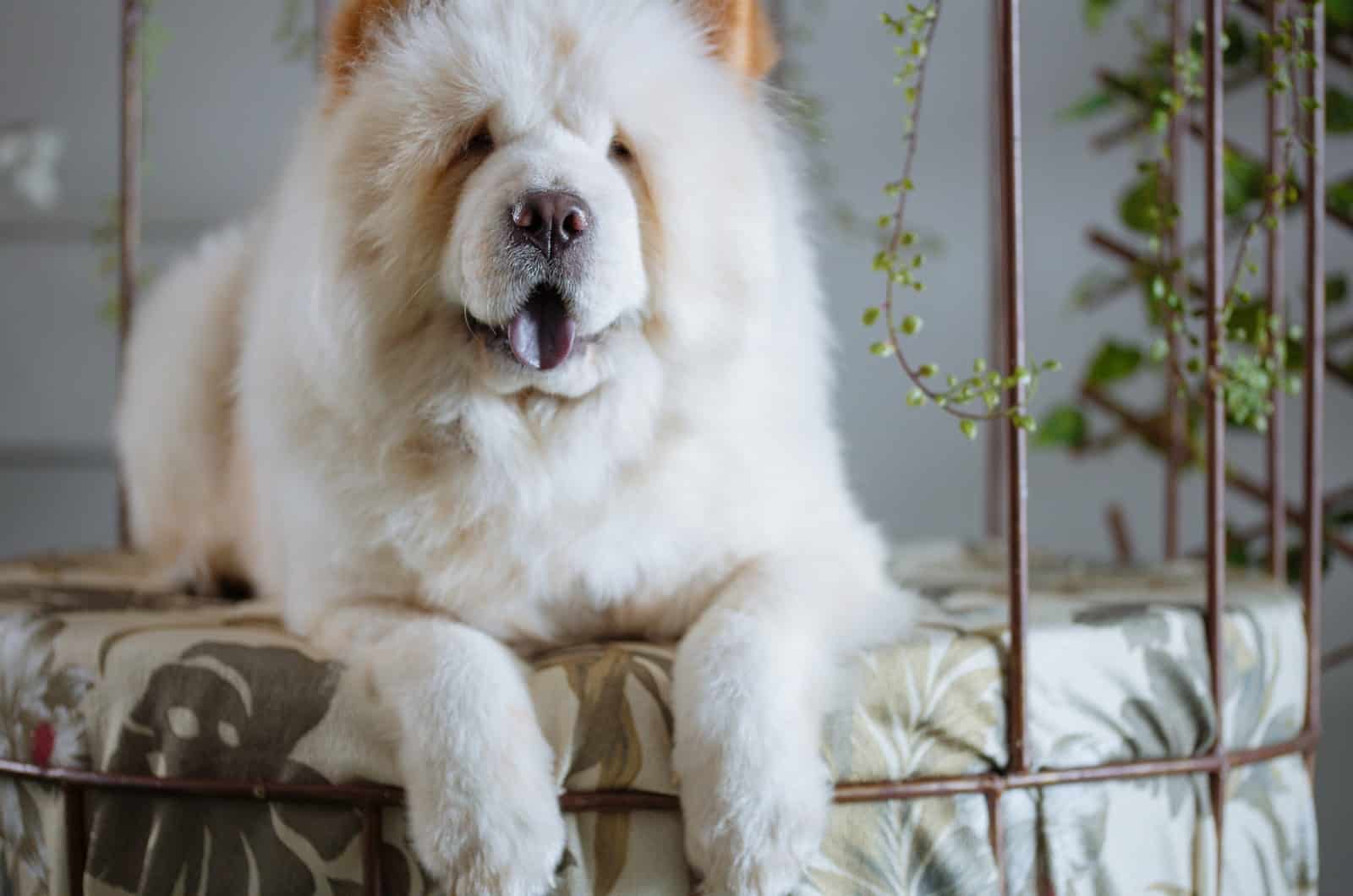
A Chow Chow Puppy feeding chart serves as a great guideline in helping new dog owners figure out what the approximate daily food intake should be for their Chow Chow puppy on average.
While the numbers offer ranges that correlate the dog’s weight with the amount of food per day, know that no dog is the same and that this will still need some fine tuning to make for the perfect diet for your canine companion.
Try to abide by as many rules as you can and feed your Chow Chow dog with a healthy and balanced diet tailored for the dog breed specifically as well as give him plenty of exercise and frequent check-ups with the vet when needed.
This should ensure a long and happy life for your dear doggo. I’m sure you’re going to be able to provide him with everything that he needs. Until next time.
RELATED LINKS:
- Mini Chow Chow — The Miniature Teddy Bear Dog
- Top 4 Chow Chow Breeders In Ontario
- Chow Chow Weight Chart: How Big Will My Chow Chow Puppy Get?
- 210 Popular Chow Chow Names For An Adorable Lion Pup
- How Much Does A Chow Chow Cost? Puppy Price And Expenses
- 8 Unique Chow Chow Colors: A Guide To Rare Patterns
- Male Vs Female Chow Chow: Who Will Win This Battle?
- Do Chow Chows Shed? Grooming Advice For Chow Chow Owners













